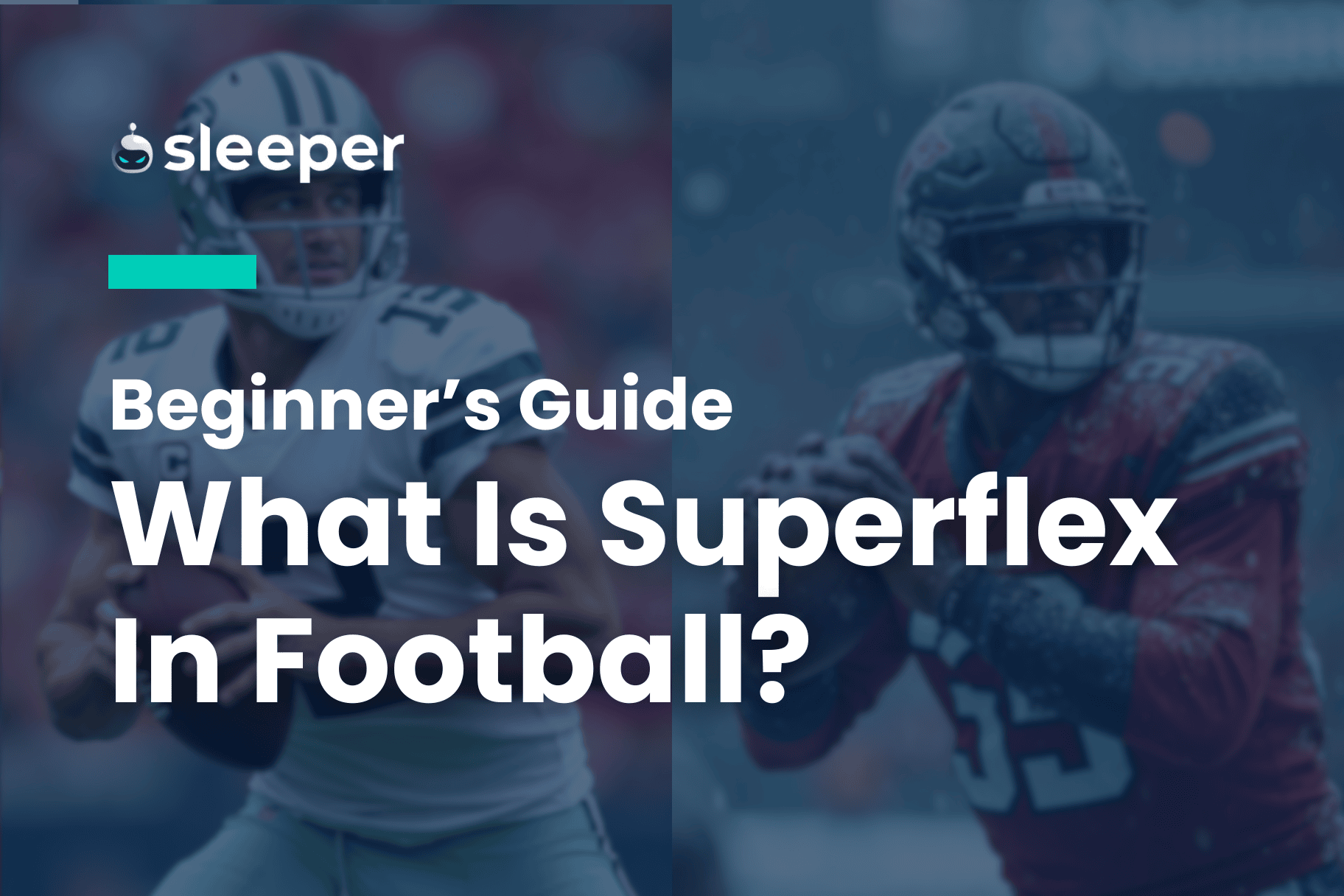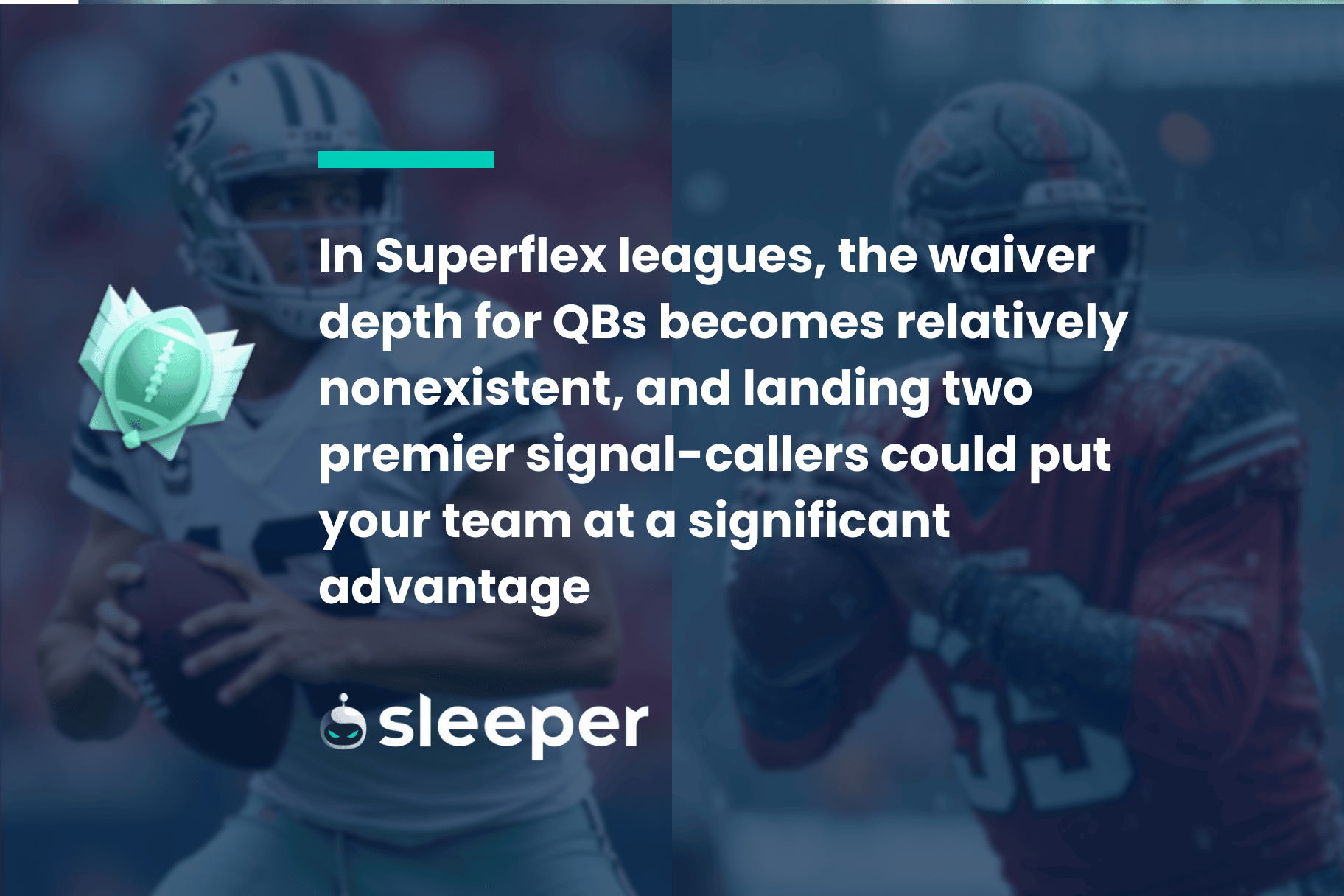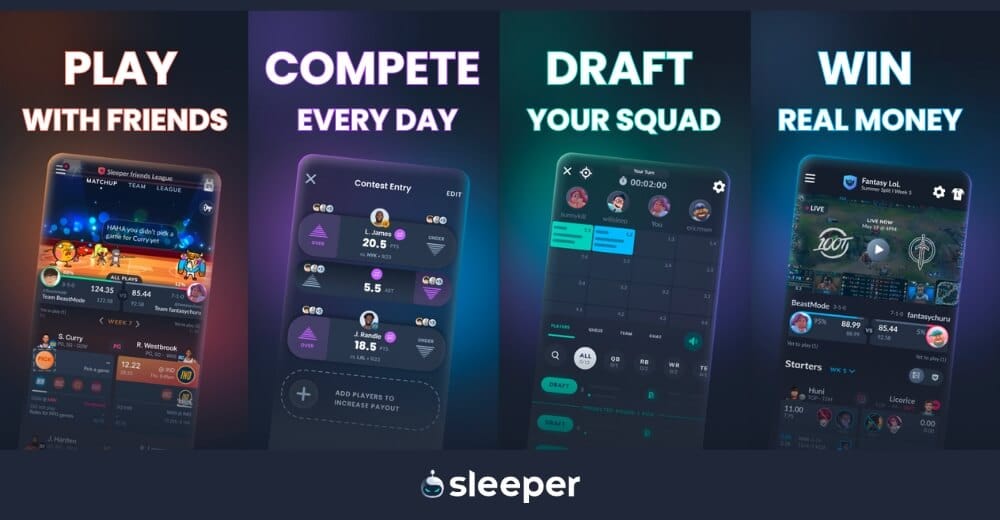If you’re new to fantasy football or seeking a change to your status quo, consider joining a superflex league, where QBs can be started in flex spots and thus carry significant additional value.

Superflex Fantasy Football: What It Is & How to Win
As you prepare for fantasy football drafts, you’ll regularly hear about how quarterbacks shouldn’t be taken early, and about how you can wait on the position. The thinking behind it is that wide receivers and running backs are players with greater value, considering that you likely start at least two of each in your lineup and the elite tiers are only so deep, so you can afford to take a QB later.
Superflex leagues allow the QB truthers to strike back.
Whether you’re new to the notion of superflex leagues or just want to refine your strategies, read on to learn more about this corner of the fantasy football landscape (and yes, before you ask, Sleeper’s season-long leagues have easy customization tools that allow commissioners to be able to create a superflex league).
What Is a Superflex League?
A superflex league allows managers to start a QB in a flex spot, which in traditional standard leagues is only reserved for running backs, wide receivers and tight ends.
The superflex setting restores value to the QB position.
Even though QBs are generally the highest-scoring players over the course of the season — even average QBs will regularly have more points than some elite offensive skill-position counterparts — you can only start one in standard league formats.
That means that there are usually serviceable, or at least streamable, options on the waiver wire on a weekly basis, and that also means you’re not incentivized to take QBs early in drafts, because it could cost you dearly at the starting RB or WR slots. Instead, more of the focus is on taking those runners and pass-catchers, with an emphasis on the latter in half-PPR and PPR leagues.
In superflex leagues, the waiver depth for QBs becomes relatively nonexistent, and landing two premier signal-callers could put your team at a significant advantage – provided you don’t completely disregard the rest of your lineup.
More features of a superflex league include:
Lineup and rosters
Superflex leagues aren’t all that different in terms of roster construction, save for the injection of the QB-eligible flex position. A standard setting may include:
- 1 Quarterback
- 2 Running backs
- 2 or 3 Wide receivers
- 1 Tight end
- 1 Flex
- 1 Superflex
- 1 Kicker
- 1 Defense
Six or seven bench spots are also common in the superflex space, making for a thinned-out waiver wire. Speaking of which…
Waiver wire
As previously alluded to, you’re unlikely to find the same kind of QB depth on the waiver wire in a superflex league as you would in a standard league. You can expect every manager to have at least two QBs on their squad, if not three. Of course, there are only 32 QB starters across the NFL at a given time, so the number of QBs left on the wire will be largely dependent on your league size.
Just as some managers will have a watchful eye on backup running backs (otherwise known as handcuffs), you’ll want to do the same for backup QBs across the league as well. All it takes is one injury to turn a bench-warming clipboard carrier into a potential league-winner.

Superflex Draft Strategy
You’re not going to want to wait on drafting QBs (at least your first QB) in superflex leagues, although the size of your league certainly plays a role in that, too. That doesn’t mean that the top RBs and WRs no longer carry value — in fact, far from it, and going QB-QB to start your draft is not necessarily advisable.
But given the additional emphasis placed on the QB position in superflex leagues, it’s not uncommon for multiple QBs to be taken in the first round. As it relates to ADP (average draft position) on Sleeper’s platforms in 2024, there were five QBs in the top 12 (Josh Allen, Patrick Mahomes, Jalen Hurts, Lamar Jackson, C.J. Stroud). Those first three names had ADPs in the top four.
That’s in stark contrast to more standard redraft leagues, where it’s viewed as a complete reach to take a QB in the first round, or even the first couple of rounds.
The upshot of not going for one of the top-ranked QBs in a superflex league — or missing on the chance to get them — is that you could wind up with some of the high-impact RBs or WRs falling more than you might expect.
If you’re picking on the turn, for instance, you could have it made at the skill positions that are usually the chief focus early in standard drafts and then turn your focus to QBs a few rungs down the ladder later on. If it’s a deeper year at the position, that’s not necessarily a bad approach to take.

Superflex Leagues vs. 2-QB Leagues: Key Differences
You may have come across 2-QB leagues in your research and think that they’re the same thing as superflex, but that is not the case.
In 2-QB leagues, you are obligated to start two quarterbacks, and flex places are still only for running backs, receivers and tight ends. In superflex leagues you have the option to start two quarterbacks, but you are under no obligation to do so (note: It is absolutely the best practice to do so).
On a week-to-week basis, once the byes hit, the differences between the leagues grow. You’ll be digging deep into the QB pool to fill out your lineup in 2-QB leagues — especially if both of your top two happen to share the same bye. In superflex leagues, you can get by from time to time with only starting one QB and using your flex places on non-QBs.
Regardless, in both leagues, QB depth is going to be depleted on the waiver wire and QBs will be prioritized during drafts. In 2-QB leagues, you’re more likely to find teams that have at least three QBs on their rosters.
Frequently Asked Questions
Where is the best spot to draft from in superflex?
If your chief objective entering a superflex draft is to walk away with one of the premier QBs, then you’ll almost certainly need to have a top-four pick. Naturally, that’s dependent on the season and the QB crop that year, but assuming that elite QB play is still reserved for a very select few, it’s going to take that early pick to land one in your draft.
What is the difference between flex and superflex?
In a straight-up flex league, the only players who can be started in the flex roster spots are running backs, wide receivers and tight ends. In superflex leagues, quarterbacks can be slotted into the flex spot.
Is superflex the same as 2-QB leagues?
They are not the same, even if both allow for two quarterbacks to be in starting lineups. Superflex leagues allow managers to start a QB in a flex spot, while 2-QB leagues have two starting places specifically for QBs, with flex places reserved for running backs, wide receivers and tight ends.
Start Your Superflex League With Sleeper
Now that you’ve become intrigued by playing in a superflex league, try your hand with Sleeper, which can accommodate free season-long leagues of all sizes and formats and offers all sorts of degrees of customization. You can sign join by either signing up on the website or downloading the app.
If you’re seeking paid-entry daily fantasy sports contests instead, then give Sleeper Picks a try. You can maximize your winnings up to 100x by simply choosing whether you think players will exceed or fall short of their projections.




